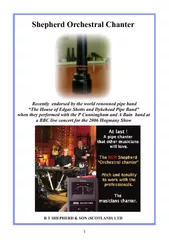PDF-Shepherd Orchestral Chanter Recently endorsed by the w
Author : lois-ondreau | Published Date : 2015-05-12
DO NOT MOISTEN THE REED Each time you blow your pipes you can repeat this exercise but employing a less severe squeeze Ensure the reed is inserted firmly into reed
Presentation Embed Code
Download Presentation
Download Presentation The PPT/PDF document "Shepherd Orchestral Chanter Recently end..." is the property of its rightful owner. Permission is granted to download and print the materials on this website for personal, non-commercial use only, and to display it on your personal computer provided you do not modify the materials and that you retain all copyright notices contained in the materials. By downloading content from our website, you accept the terms of this agreement.
Shepherd Orchestral Chanter Recently endorsed by the w: Transcript
Download Rules Of Document
"Shepherd Orchestral Chanter Recently endorsed by the w"The content belongs to its owner. You may download and print it for personal use, without modification, and keep all copyright notices. By downloading, you agree to these terms.
Related Documents














